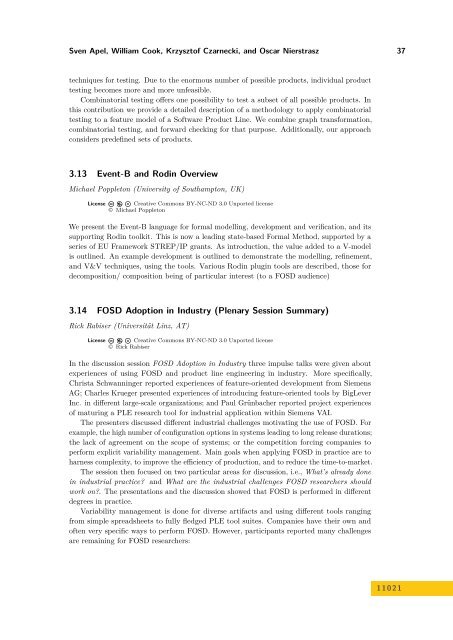Volume 1, Issue 1, January 2011 - DROPS - Schloss Dagstuhl
Volume 1, Issue 1, January 2011 - DROPS - Schloss Dagstuhl
Volume 1, Issue 1, January 2011 - DROPS - Schloss Dagstuhl
You also want an ePaper? Increase the reach of your titles
YUMPU automatically turns print PDFs into web optimized ePapers that Google loves.
Sven Apel, William Cook, Krzysztof Czarnecki, and Oscar Nierstrasz 37<br />
techniques for testing. Due to the enormous number of possible products, individual product<br />
testing becomes more and more unfeasible.<br />
Combinatorial testing offers one possibility to test a subset of all possible products. In<br />
this contribution we provide a detailed description of a methodology to apply combinatorial<br />
testing to a feature model of a Software Product Line. We combine graph transformation,<br />
combinatorial testing, and forward checking for that purpose. Additionally, our approach<br />
considers predefined sets of products.<br />
3.13 Event-B and Rodin Overview<br />
Michael Poppleton (University of Southampton, UK)<br />
License Creative Commons BY-NC-ND 3.0 Unported license<br />
© Michael Poppleton<br />
We present the Event-B language for formal modelling, development and verification, and its<br />
supporting Rodin toolkit. This is now a leading state-based Formal Method, supported by a<br />
series of EU Framework STREP/IP grants. As introduction, the value added to a V-model<br />
is outlined. An example development is outlined to demonstrate the modelling, refinement,<br />
and V&V techniques, using the tools. Various Rodin plugin tools are described, those for<br />
decomposition/ composition being of particular interest (to a FOSD audience)<br />
3.14 FOSD Adoption in Industry (Plenary Session Summary)<br />
Rick Rabiser (Universität Linz, AT)<br />
License Creative Commons BY-NC-ND 3.0 Unported license<br />
© Rick Rabiser<br />
In the discussion session FOSD Adoption in Industry three impulse talks were given about<br />
experiences of using FOSD and product line engineering in industry. More specifically,<br />
Christa Schwanninger reported experiences of feature-oriented development from Siemens<br />
AG; Charles Krueger presented experiences of introducing feature-oriented tools by BigLever<br />
Inc. in different large-scale organizations; and Paul Grünbacher reported project experiences<br />
of maturing a PLE research tool for industrial application within Siemens VAI.<br />
The presenters discussed different industrial challenges motivating the use of FOSD. For<br />
example, the high number of configuration options in systems leading to long release durations;<br />
the lack of agreement on the scope of systems; or the competition forcing companies to<br />
perform explicit variability management. Main goals when applying FOSD in practice are to<br />
harness complexity, to improve the efficiency of production, and to reduce the time-to-market.<br />
The session then focused on two particular areas for discussion, i.e., What’s already done<br />
in industrial practice? and What are the industrial challenges FOSD researchers should<br />
work on?. The presentations and the discussion showed that FOSD is performed in different<br />
degrees in practice.<br />
Variability management is done for diverse artifacts and using different tools ranging<br />
from simple spreadsheets to fully fledged PLE tool suites. Companies have their own and<br />
often very specific ways to perform FOSD. However, participants reported many challenges<br />
are remaining for FOSD researchers:<br />
1 1 0 2 1













